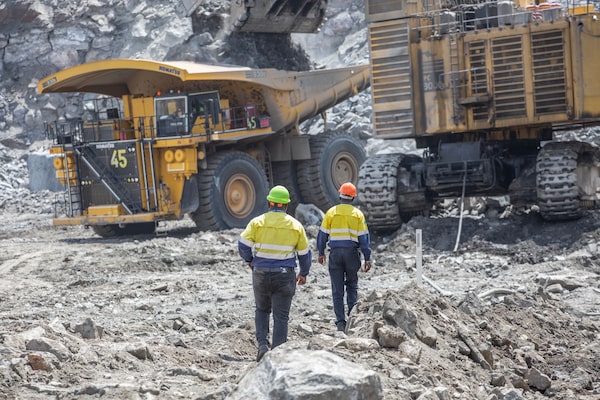
Barrick’s Lumwana copper mine is located about 100 km west of Solwezi in Zambia’s Copperbelt.Abbas Makke/Supplied
Barrick Gold ABX-T says it has found uranium in the drinking water of an open section of its Lumwana copper mine in Zambia, forcing it to halt the water supply and switch to other water sources for its workers in the section.
The Zambian mine has become increasingly important to Barrick’s future. The Toronto-based company has announced plans for a US$2-billion expansion at Lumwana to create one of the world’s biggest copper mines, with construction to begin late this year and production from the project expected by 2028.
Tests of drinking water in the mine’s Chimiwungo open section on Nov. 8 found a Uranium level of 0.037 milligrams per litre, exceeding Zambia’s maximum allowable limit of 0.03 milligrams, according to a statement by Barrick’s country manager in Zambia, Anthony Malenga.
Canada’s health guidelines set a maximum of 0.02 milligrams, so the level at Lumwana was nearly twice the Canadian limit.
In an internal e-mail on Nov. 8, seen by The Globe and Mail, a Barrick official said the drinking water was “high in uranium” and “contaminated with uranium.” The official, Oreen Kinyanta, told colleagues: “Please don’t use it.”
The company says it immediately stopped the supply of water to the work force in the affected area and switched to bottled water. On Feb. 20, the company began taking water from a municipal water treatment plant, allowing the bottled water to be discontinued, according to an internal memo seen by The Globe.
Mr. Malenga, in a statement sent to a Zambian newspaper last month, said the employees were exposed to uranium for two days, but their exposure was “negligible due to both the duration and low concentration.” The calculated uranium exposure was “well below” the World Health Organization guidelines, he said.
Barrick did not respond to questions from The Globe about how exactly the uranium entered the water supply, how many employees were affected and the uranium levels in the water supply before and after the Nov. 8 tests.
In a brief statement to The Globe, however, Barrick said the incident was isolated to a small part of the mine, caused no damage to anyone’s health and posed no risk to other employees, contractors or people in surrounding communities.
The company said it does not produce uranium at Lumwana in any form. Uranium is a naturally occurring element in the region, it said in the unsigned statement. Barrick spokesperson Kathy du Plessis said it was a “company statement.”
Uranium and copper ore can be embedded in the same rocks. From 2008 to 2011, Lumwana stockpiled more than four million tonnes of uranium as a byproduct of its copper production when the mine was owned by Equinox Minerals.
Barrick acquired the mine from Equinox for $7.3-billion in 2011. Equinox had planned to build a uranium processing facility at Lumwana, and Barrick executives said in 2011 that the company would consider the same option. But ultimately it did not pursue the processing plan.
Despite Barrick’s assurances about worker health after the uranium contamination, the incident led to a verbal clash between a trade union official and a company manager. The union official, Kelvin Chiwaya, who had worked in the mine for 11 years, said he was fired by the company in January after he accused the manager of misleading the employees. He is now suing the company for wrongful dismissal.
Asked about the case, Barrick told The Globe: “Regarding the allegation that an employee was fired for speaking out on this issue, the company’s policy is to not publicly disclose the reasons for a dismissal.”
Mr. Chiwaya, who remains an official in Lumwana’s mineworker union, said the union’s members are worried that their health may have been damaged by the uranium in the water.
The company has refused to disclose the results of its water tests, aside from the Nov. 8 test, he told The Globe in an interview. “They’re keeping things secret.”
He estimated that at least 800 workers were exposed to the drinking water before it was shut down. When bottled water was provided, it was limited and insufficient, he said.
Barrick announced in January that it is accelerating its expansion project at the Zambian mine. The expansion will help the mine reach a projected annual production of 240,000 tonnes of copper per year, over a life of more than 30 years.
It said the mine has contributed almost US$3-billion to the Zambian economy since 2019 in the form of royalties, taxes, salaries and the procurement of goods and services from local businesses.